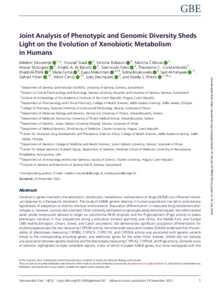Document
Joint analysis of phenotypic and genomic diversity sheds light on the evolution of xenobiotic metabolism in humans.
Identifier
DOI: 10.1093/gbe/evac167
Source
Genome Biology and Evolution. v. 14, 12, evac167
Contributors
Daali, Youssef., Author
Rollason, Victoria., Author
Čížková, Martina., Author
Mulugeta, Anwar., Author
Al-Balushi, Khalid A., Author
Fakis, Giannoulis., Author
Constantinidis, Theodoros C., Author
Al-Thihli, Khalid., Author
Černá, Marie., Author
Makonnen, Eyasu., Author
Boukouvala, Sotiria., Author
Al-Yahyaee, Said., Author
Yimer, Getnet., Author
Černý, Viktor., Author
Desmeules, Jules., Author
Poloni, Estella S., Author
Country
United Kingdom.
City
Oxford.
Publisher
Oxford University Press.
Gregorian
2022-12-01
Language
English
English abstract
Variation in genes involved in the absorption, distribution, metabolism, and excretion of drugs (ADME) can influence individual response to a therapeutic treatment. The study of ADME genetic diversity in human populations has led to evolutionary hypotheses of adaptation to distinct chemical environments. Population differentiation in measured drug metabolism phenotypes is, however, scarcely documented, often indirectly estimated via genotype-predicted phenotypes. We administered seven probe compounds devised to target six cytochrome P450 enzymes and the P-glycoprotein (P-gp) activity to assess phenotypic variation in four populations along a latitudinal transect spanning over Africa, the Middle East, and Europe (349 healthy Ethiopian, Omani, Greek, and Czech volunteers). We demonstrate significant population differentiation for all phenotypes except the one measuring CYP2D6 activity. Genome-wide association studies (GWAS) evidenced that the variability of phenotypes measuring CYP2B6, CYP2C9, CYP2C19, and CYP2D6 activity was associated with genetic variants linked to the corresponding encoding genes, and additional genes for the latter three. Instead, GWAS did not indicate any association between genetic diversity and the phenotypes measuring CYP1A2, CYP3A4, and P-gp activity. Genome scans of selection highlighted multiple candidate regions, a few of which included ADME genes, but none overlapped with the GWAS candidates. Our results suggest that different mechanisms have been shaping the evolution of these phenotypes, including phenotypic plasticity, and possibly some form of balancing selection. We discuss how these contrasting results highlight the diverse evolutionary trajectories of ADME genes and proteins, consistent with the wide spectrum of both endogenous and exogenous molecules that are their substrates.
ISSN
1759-6653
Resource URL
Category
Journal articles

